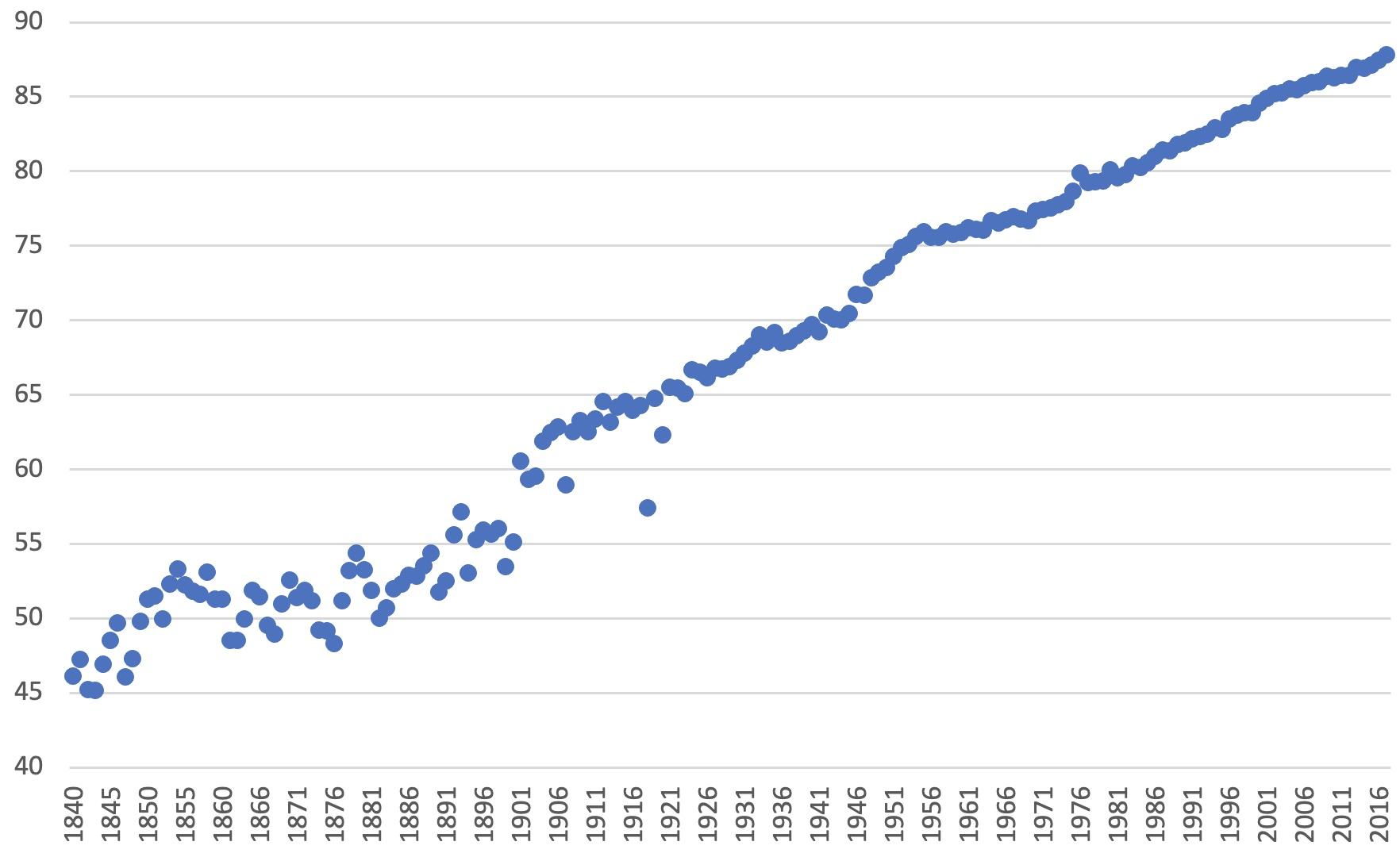Life expectancy has increased dramatically over the last 150 years (Oeppen and Vaupel 2002), although not all the extra years gained have been healthy. Since the proportion of life in good health has remained broadly constant (GBD 2019 Demographics Collaborators), this implies an increase in the number of years in poor health. That has shifted the disease burden towards chronic non-communicable diseases (NCDs), estimated to cause over 71% of deaths globally. Prominent amongst these NCDs are age-related diseases such as dementia, cancer, chronic obstructive pulmonary diseases, cardiovascular diseases, and diabetes.
Figure 1 Best practice life expectancy, 1840-2017
Note: Best practice life expectancy defined as country with highest average life expectancy at birth.
Source: Human Mortality Database
As a consequence, there is a growing emphasis on ‘healthy ageing’ and an emerging body of research focusing on the biology of ageing (Sinclair 2019), holding out the prospect of treatments that may delay or even reverse the effects of ageing. Whilst economic concerns about an ageing society focus on changes in the age structure of the population, is there a longevity dividend (Scott 2021) to be seized by changing how we age?
To estimate the economic value of delaying ageing, in a new paper (Scott et al. 2021) we utilise the value of statistical life (VSL) model of Murphy and Topel (2006). This framework enables us to place a monetary value on the willingness to pay (WTP) for various hypothetical interventions that lead to improvements in life expectancy, compressions of morbidity and delays in ageing. Using this framework leads to the following insights.
- Gains to life expectancy that do not lead to improvements in health are characterised by diminishing returns.
Based on current US health and life expectancy data, a lowering of mortality rates that increases life expectancy by one year relative to its current 78.9 years is worth $118,100. An additional further increase (raising life expectancy from 79.9 to 80.9) is worth $114,100 and the WTP continues to decline in response to further gains. Gains diminish because of discounting (events happening ever further into the future) and because health is declining with age.
- Gains to life expectancy are greatest for the old.
An 80 year-old values an additional year of life expectancy (taking remaining life expectancy from 8.4 to 9.4 years) as worth $312,200, compared to $118,100 for a new-born. WTP rises with age due to discounting and the proximity of the gain for older people. It also rises because the probability of an 80 year-old reaching 88.4 years is significantly higher than for someone who is new-born.
- Achieving a full compression of morbidity is valued more highly than any further gains in life expectancy, but improvements in health also experience diminishing returns.
For a new-born in the US, increasing healthy life expectancy from the current value of 68.5 to 69.5 years is worth $242,000, but a further year (going from 69.5 to 70.5 years) is worth $233,400 and then $224,100, and so on. Although declining, the value of an extra year of healthy life expectancy is always worth more than the value of increasing US life expectancy from its current value of 78.9 years. Achieving a full compression of morbidity (Fries 1980) is a more important health priority than extending life.
- The gains from delaying ageing exceed those of raising health or extending life expectancy, and diminish more slowly. Delaying ageing exploits the complementarity between healthspan and lifespan.
Delaying ageing involves changing the relationship between chronological and biological age such that both mortality rates and frailty improve at every age. The value of delaying ageing in this way such that life expectancy increases by an extra year (from 78.9 to 79.9 years) is $178,700 to the individual. This is larger than for just increasing life expectancy because health is also improving. Complementarities between health and lifespan also mean that diminishing returns operate more slowly.
- The prospective gains from delaying ageing are substantial compared to treatments focused on single diseases due to aggregation and competing risks.
One drug that is being extensively researched for its anti-ageing properties is the diabetic treatment metformin. Crucially, the validity (and safety) of metformin as an anti-ageing drug awaits confirmation from the ongoing TAME trial. However, a number of studies suggest metformin may have “protective effects against several age-related diseases” (Barzilai et al. 2016). For illustrative purposes we use the results of Wang et al. (2017) to infer the gains from a hypothetical successful treatment that delays ageing (which Metformin may or may not prove to be) and so postpones the incidence of multiple age-related diseases. We compare these gains with those from eradicating major single disease categories, such as cancer and dementia.
The results are shown in Table 1. As expected, the economic value of delaying ageing is substantial and frequently larger than that of eradicating major single diseases. The magnitude of the gains from delaying ageing occur through two channels. The first is they impact the incidence of several diseases and so aggregate across the gains across them. The second is due to competing risks (Dow et al. 1999). The gains from eradicating a single disease are substantial but are limited by the presence of other illnesses – for example, the gains from eradicating cancer are limited because of the incidence of dementia. In contrast, delaying ageing reduces the incidence of multiple diseases and so limits these competing risks. Hence the gains from delaying ageing are greater than the sum of its impact on each individual disease.
Table 1 Willingness to pay (WTP) for metaformin treatments and disease eradications ($ thousand)
Note: The life expectancy remaining at ages 0, 20, 40, 60, 80 when not taking metaformin is 78.9, 59.0, 39.5, 21.7 and 8.4 years. At these ages when taking metaformin it is 82.7, 62.9, 43.3, 25.2 and 3.0 years.
- A virtuous circle exists at the aggregate level such that the gains to how we age increase the more successful we are at delaying ageing. This occurs because delaying ageing increases the average age of society and leads to more people alive, both of which raise the value of further improvements in ageing.
Our results have so far have focused on individual gains, but we can sum across the age distribution of the US to calculate the aggregate gains. An intervention that delays ageing such that life expectancy increases by one year (and health improves too) is worth $38 trillion ($30 trillion if we ignore the benefits that accrue to as yet unborn generations).
Focusing on aggregate values introduces an additional dynamic into our calculations, as improvements in ageing lead to an increase in the average age of society and to more people alive. Both of these boost the value of further improvements in delaying ageing. These two effects are sufficient to offset the diminishing returns to delaying ageing that occur at the individual level.
According to the United Nations, every country around the world is expected to see further increases in life expectancy and a rising share of older people in the next 30 years. The result is a shift in the diseases that the health system needs to target. Based on current US health and longevity data, we show that compressing morbidity is more valuable than any further gains to life expectancy. Our calculations suggest substantial value in treatments that target ageing and that these gains exceed those from focusing on individual diseases. We also reveal a striking dynamic whereby the better society gets at ageing, the more it values further gains to ageing. Complementarities between health and life expectancy, the elimination of competing risks, and the rising average age of society and the number of older people all mean that increasingly society will be focused on new health imperative – ‘all’s well that ages well’.
References
Barzilai, N, J P Crandall, S B Kritchevsky and M A Espeland (2016), “Metformin as a Tool to Target Aging”, Cell Metabolism 23(6): 1060-1065.
Dow, W H, T J Philipson, and X Sala i Martin (1999), “Longevity Complementarities under Competing Risks”, American Economic Review 89(5): 1358-1371.
JFries, J F (1980), “Aging, Natural Death, and the Compression of Morbidity”, New England Journal of Medicine 303(3): 130-135.
GBD 2019 Demographics Collaborators (2020), “Global age-sex-specific fertility, mortality, healthy life expectancy (HALE), and population estimates in 204 countries and territories, 1950–2019: a comprehensive demographic analysis for the Global Burden of Disease Study 2019”, The Lancet 396(10258).
Murphy, K M and R H Topel (2006), “The Value of Health and Longevity”, Journal of Political Economy 114(5): 871-904.
Oeppen, J and J W Vaupel (2002), “Broken Limits to Life Expectancy”, Science 296(5570): 1029-1031.
Scott, A J (2021), “Achieving a three-dimensonal longevity dividend”, Nature Aging 1: 500-505.
Scott, A J, M Ellison, and D A Sinclair (2021), “The Economic Value of Targeting Aging”, Nature Aging 1: 616-623.
Sinclair, D A (2019), Lifespan: Why We Age - and Why We Don't Have To, Thorsons.
Wang, C-P, C Lorenzo, S L Habib, B Jo, and S E Espinoza (2017), “Differential effects of metformin on age related comorbidities in older men with type 2 diabetes”, Journal of Diabetes and its Complications 31(4): 679-686.
Endnotes
1 https://www.afar.org/tame-trial





